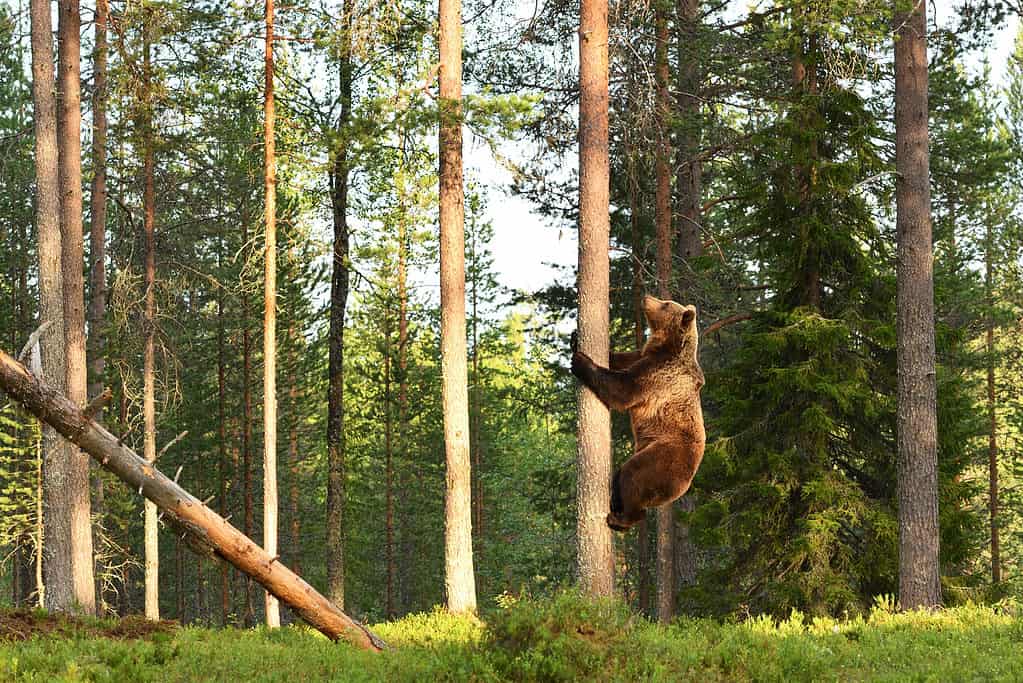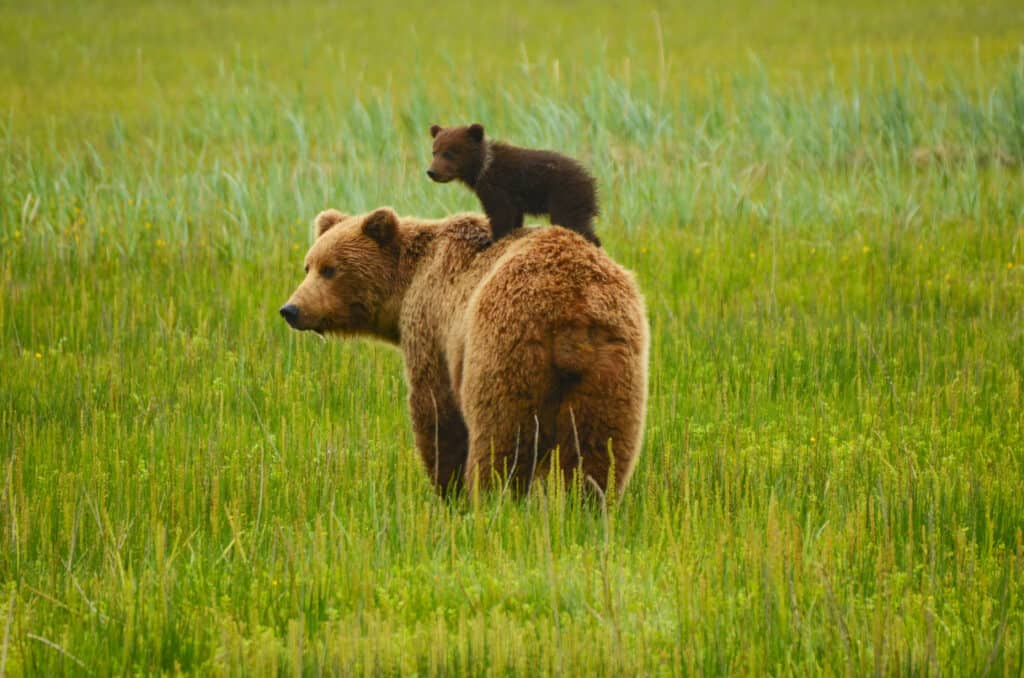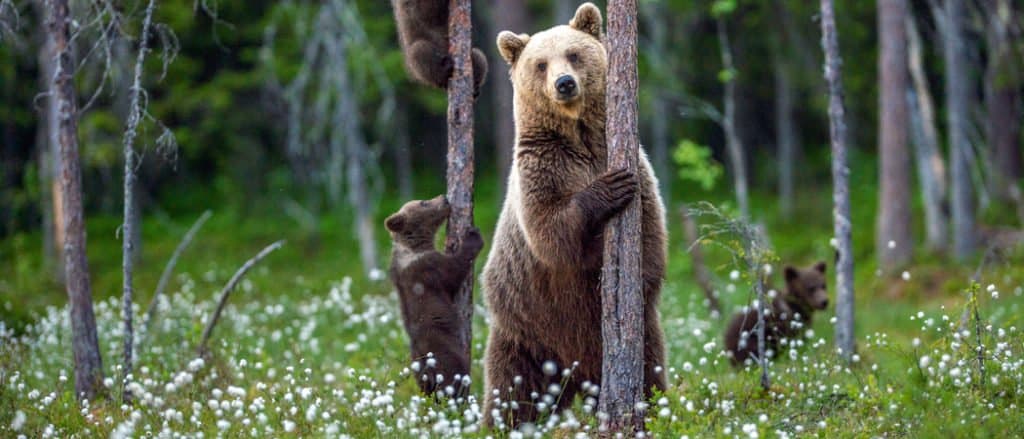Brown bears are some of the largest bears found throughout the world. They forage tiny fruits like berries and go after some seriously large mammals as well. They can run fast, and they intimidate with their size alone. But can they climb trees? In this article, we answer that question and provide you with some more background information, including how they fare in climbing abilities compared with other types of bears. (Almost) no one expects to run into a big brown bear, but even if you do, you must know that climbing a tree isn’t the best getaway plan.
Species Profile: Brown Bears

Contrary to popular belief, grizzly bears can climb trees.
©iStock.com/ErikMandre
Brown bears are the second largest bears found throughout the world, close behind polar bears. ‘Brown bears’ is an umbrella term encompassing several species worldwide. For example, brown bears are called grizzly bears in North America.
However, in Alaska, particularly the Kodiak Islands, the brown bears are called Kodiak bears. Because brown bears vary depending on their location, their typical size has quite a range. Not to mention that their weight shifts during the year — they’re much heftier just before winter hibernation and emerge lighter due to lack of foraging when spring rolls around.
Female bears retreat to dens when they’re pregnant and keep their cubs alongside them for up to three years. After that initial period, the females can reproduce again. Mother bears pose a more serious danger to humans because of their fiercely protective natures, and despite being so big, they can still move swiftly, reaching up to 30 miles per hour!
Where do Brown Bears Live?
Brown bears can be found throughout the world, gracing several continents, including Europe, Asia, and North America. These bears are large, but the most towering ones can be found in Alaska and on the coast of British Columbia, where they have an overabundance of food.
How Many Kinds of Brown Bears Are There?

Mother bears need to teach cubs to climb.
©David Rasmus/Shutterstock.com
There are quite a number of brown bears found throughout the world! Those bears include:
- Eurasian brown bears
- Syrian Brown bears
- Ussuri brown bears
- Cantabrian brown bears
- Tibetan blue bears
- Alaska Peninsula brown bears
- Himalayan brown bears
- ABC Islands bears
- Marsican brown bears
- Gobi bears
- Kamchatka brown bears
- California grizzly bears
- East Siberian brown bears
- Atlas bears
- Steppe brown bears
What Do Brown Bears Eat?
Brown bears eat various foods, but their primary diet comprises what they can forage, including roots, berries, nuts, and fruit. These are powerful hunters, however, so they can take down an animal as small as a rodent or a medium-sized deer and overpower huge mammals like elk and moose.
Are Brown Bears Able to Climb Trees?

Black bears take the cake regarding speed, and sloth bears can climb just about anything but don’t second guess brown bears either.
©iStock.com/USO
Although you might raise an eyebrow considering the size of brown bears, the answer is: Yes! Brown bears can climb trees! It’s a myth that they can’t scale up a tree. Although they are in second place to polar bears regarding how large they grow, they beat polar bears in their ability to climb. To be fair, however, they are not the most adept climbers (primarily because of their large size).
Black bears take the cake regarding speed, and sloth bears can climb just about anything but don’t second guess brown bears either. If there’s something of interest up in a tree, they don’t hesitate to use their claws to start a vertical path. It’s especially easy for them if the tree has branches closer to its trunk that they can use as a makeshift ladder.
Facts to Know About Brown Bears
1. Brown bears use their feet creatively when they’re ready to start mating. Instead of their usual stroll or occasional fast-paced run, they twist their feet into the ground to mark it with their scent, letting other bears in the area know they’re ready to meet up! Unless they’re seeking a mate or it’s a mother bear with her cubs, brown bears spend most of their time on their own.
2. When brown bear cubs are born, they’re not hairy and ready to check out their environment. They are born without fur and completely blind. These cubs rely wholly on their mother to survive, and it’s why having a den is vital to keeping them alive. In a way, the den serves as a second womb so bear cubs can continue developing.
3. When in the wild, brown bears may live up to 30 years old, and when in sanctuaries, they can even make it past their 40s. In fact, there was a European brown bear whose name was Andreas, that died on May 24, 2013, at the age of 50. This brown bear was rescued in 1993 and lived in a sanctuary provided by the World Society for the Protection of Animals until its death.
The photo featured at the top of this post is © Perpis/Shutterstock.com
Thank you for reading! Have some feedback for us? Contact the AZ Animals editorial team.






